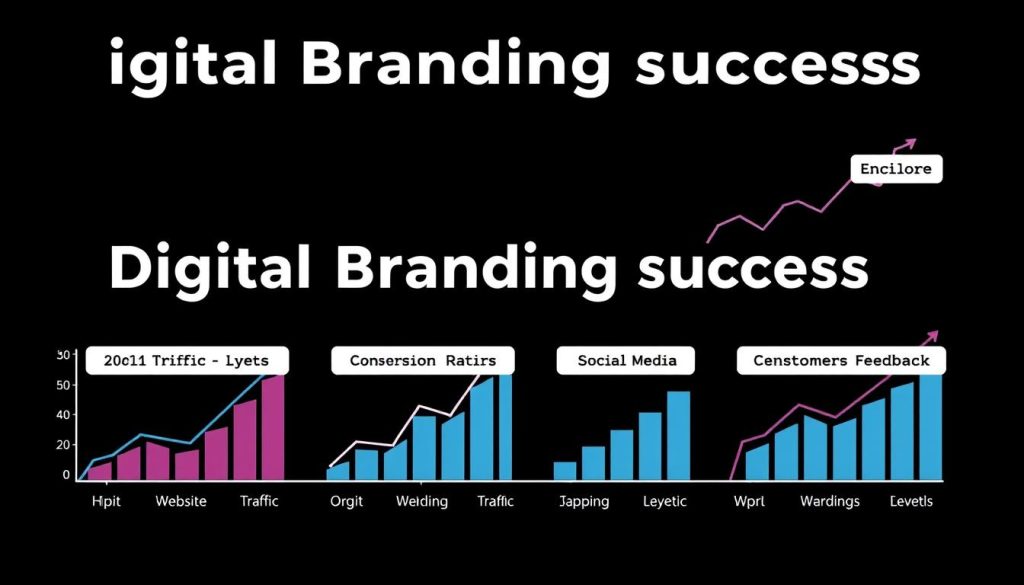Digital branding is now crucial for setting up a business online. With more people using online platforms, making a good digital branding strategy is key. It means using digital tools and channels well to make a brand stand out. It’s about creating a story and images that talk to your target audience and set your brand apart from others. Building a digital brand isn’t just a one-time thing; it impacts how a company is seen both online and offline. So, mixing your digital brand identity with your main business plans is vital. This mix helps a business to keep growing and succeeding in the fast-moving digital world.
Key Takeaways
- Getting the basics of digital branding right is the first step to being seen online.
- Creating a winning digital branding strategy means using lots of different digital tools and spaces.
- It’s important to have a brand identity that’s easy to recognise to beat the competition.
- Your digital brand growth should go hand in hand with your overall business goals for lasting success.
- Having a story and look that speak to your audience is key.
Understanding the Importance of Digital Branding
In our digital-first world, having strong digital branding is key. It lets businesses stand out and build brand recognition. They can connect better with customers who shop online. This is vital in today’s competitive online market.
Digital branding isn’t just about being online. It’s about making a brand that speaks to people. Companies use social media, SEO, and content marketing to connect. This helps them create a unique and appealing online identity.
A good digital brand brings many rewards. It can win customer loyalty and build trust. It also gives businesses an edge in the online world. Companies that get this right often grow and succeed. They know investing in digital branding pays off by making their online presence stronger.
Identifying Your Brand’s Core Values
Understanding your brand’s core values is key. It forms the base of all branding choices. Knowing what your brand stands for helps keep your digital branding clear and consistent.
Defining Your Mission Statement
Your mission statement is crucial. It should be clear and impactful, guiding your brand’s strategy and sharing its goals with the public. It tells people what your brand aims to achieve in the market and society.
Aligning Values with Audience Needs
It’s important your brand connects with your audience. By matching your values with what your audience expects, you create a strong emotional bond. This bond helps in keeping loyal customers by addressing their likes and issues.
Ensuring Consistency Across Channels
Being consistent across all digital channels strengthens your brand. It makes your brand easily recognized and trusted by your audience. Whether on social media, your website, or in online ads, keeping a uniform message builds audience trust.
- Social Media: Keep a consistent look and tone on all platforms.
- Websites: Your website should mirror the values and mission of your brand.
- Online Advertising: Your ads should reflect your brand’s core values and goals.
Focusing on these areas helps shape a strong branding strategy. It ensures your brand’s message reaches the audience effectively, maintaining integrity across digital spaces.
Leveraging Social Media for Brand Awareness

Social media can hugely increase brand visibility due to its vast audience and interaction options. The trick is picking the right channels, crafting engaging posts, and using analytics to improve. This approach ensures your brand stands out on social media.
Choosing the Right Platforms
It’s important to know where your audience hangs out online. For example, a fashion label might choose Instagram and Pinterest. Meanwhile, a tech firm may go for LinkedIn and Twitter. Knowing this helps you make content that reaches and engages your audience effectively.
Creating Engaging Content
Content is crucial on social media. Your strategy should mix images, videos, infographics, and texts. These should grab attention but also be relevant to your followers. Brands like Nike and Apple are great at making content that their audience loves to share.
Utilising Analytics for Better Decisions
Finally, social analytics are key to honing your strategy on social networks. They let you see what’s working through likes, shares, and comments. With tools like Google Analytics and Hootsuite, you can understand your audience better. This info lets you make smarter choices for your social media efforts.
Creating Your Digital Branding
To start building a strong digital brand, you first need to focus on creating your brand identity. Choose the right colours, fonts, and images that match your brand’s message and appeal to your audience. The journey of making your brand stand out online involves mixing various elements to craft a unique visual identity.
A key step in creating a brand identity is to tell a powerful story. This story forms the base of all your content and how you talk to your audience. To do this well, you must get to know what your audience likes and share a story they’ll want to hear.
Having a great look online is more than just being pretty. You must plan carefully how to show up online to truly connect with your customers and fans. Doing this right helps build a strong bond, encourages loyalty, and makes people want to support your brand.
- Choose a consistent colour palette that represents your brand’s personality.
- Select typography that conveys your brand’s tone and values.
- Utilise high-quality imagery that aligns with your brand’s message.
- Create a narrative that connects emotionally with your audience.
- Develop a content strategy that consistently reinforces your brand’s story.
In conclusion, creating an identifiable brand identity and a strong online presence are crucial for your brand’s success in the digital world. By concentrating on these essential parts, you’re building a strong foundation for your digital branding strategy. This strategy will support your brand’s growth and change over time.
Optimising Your Website for a Strong Digital Presence
Your website is often the first thing potential customers see. This makes website optimisation vital for a strong online presence. Key elements include following SEO best practices, having a user-friendly design, and ensuring your site works well on mobile. These factors make your website more engaging and visible.
SEO Best Practices
Good SEO techniques help your site appear higher in search results on engines like Google. This includes using the right keywords, creating quality content, and building backlinks. These steps make your website easier to find, drawing in more visitors.
Implementing User-Friendly Design
A user-friendly design makes your site easy and satisfying to use. It means having a clear layout, with straightforward calls to action and attractive design. Focusing on a good user experience means people will likely stay longer on your site. This can lead to more sales and subscribers.
Ensuring Mobile Responsiveness
With more people using mobile devices, having a responsive web design is crucial. Your site must work well on all screen sizes. This makes users happy and more engaged. Happy users often turn into loyal customers, which is good for your business.
Effective Use of Digital Advertising

Today’s businesses need to understand digital advertising strategies well. They use online platforms to target certain groups, making their online ads more powerful. Each platform has its own perks. Using a mix can really boost campaign success.
Here are the main things needed for successful campaigns:
- It’s important to set clear, measurable goals. This way, you can check on progress and ROI.
- Using pay-per-click (PPC) helps put your ads at the top of search engine results. This brings in quality visitors.
- Display ads on websites relevant to your brand can increase visibility and attract more customers.
- Social media is great for reaching out to certain audiences and building stronger connections.
Note the importance of watching and tweaking your digital advertising strategies. Analytics tools are super useful. They show how your ads are doing in real-time. With these insights, you can make quick changes to get better results. Staying up to date with the latest trends and adjusting your methods is key. This ensures your digital ads not only make an impact but are also cost-effective.
Utilising Influencer Partnerships
Influencer partnerships are key to boosting brand visibility and trust. By teaming up with influencers who share your brand’s values and have a strong follower base, businesses can create meaningful connections. This benefits both the brand and the influencers.
Identifying the Right Influencers
Finding the right influencers is vital for a campaign’s success. Brands must look for influencers whose values match theirs and who have an engaged audience. Using tools to assess influencer metrics can help make this easier.
Creating Authentic Collaborations
The heart of successful influencer partnerships is being genuine. When brands form real bonds, the collaboration seems honest to the audience. This kind of authentic partnership builds trust and credibility, making a bigger impact.
Measuring Impact and ROI
It’s crucial to evaluate how well influencer campaigns perform. Brands should measure success by looking at engagement, conversion rates, and how the audience grows. Understanding these metrics shows the return on investment in influencer marketing and helps improve future plans.
Developing a Consistent Brand Voice
Developing a consistent brand voice is key to creating a clear and recognizable brand identity. It shows the brand’s personality and values. This is done by using a consistent tone, style, and language across all ways of communication.
To achieve brand voice consistency, a well-thought-out communication strategy is needed. This strategy makes sure brand messages stay true to the brand’s core beliefs. This creates familiarity and trust with the audience. Keeping this consistent voice is vital to stand out in the market.
A detailed communication strategy is crucial to keep brand messaging consistent across platforms. It requires understanding how the brand wants to be seen by its customers. By following this strategic approach, brands can maintain a consistent voice. This voice will connect with their audience and strengthen their position in the market.
- Define your brand’s personality traits and tone clearly.
- Ensure all team members understand and implement the brand voice guidelines.
- Review communications regularly to maintain uniformity in tone and style.
In conclusion, having a consistent brand voice is essential for a trustworthy and recognisable brand identity. Strategic communication and clear messaging are crucial. They not only make the brand stand out but also create a strong bond with customers.
Effective Content Marketing Strategies
Content marketing strategies are key for drawing and keeping customers. This is done through creating and sharing valuable content. Using an editorial calendar, brands can keep a steady flow of content. This content matches their marketing goals.
Creating a Content Calendar
An editorial calendar is vital for organizing content marketing. It helps plan when to publish content. It also creates a pattern that your audience will love. With this plan, brands stay on top in fast-changing digital marketing.
Incorporating Multimedia
Adding multimedia like videos, infographics, and podcasts makes content more engaging. Different media types appeal to different people, making content more likely to be shared. Rich multimedia content boosts your marketing strategy’s impact.
Engaging with Your Audience
Engagement is about connecting two ways. It’s important to encourage interaction like comments, shares, and feedback. This builds a community feel and strengthens brand-consumer relationships. Active engagement gets valuable feedback and builds trust. This leads to the success of your content marketing efforts.
Building Trust Through Authenticity
Today, creating trust in a brand is essential for growth and loyalty. It all starts with being authentic in your branding. This means always sticking to your core values and keeping your promises. A brand that’s true to itself builds trust and strengthens its bond with customers.
Being transparent and consistent is key to true brand engagement. A brand that communicates openly and fairly shows it values authenticity. Using honest marketing and ethically sourced products appeals to customers who prize integrity.
- Adopt transparent communication
- Embrace ethically sourced materials
- Invest in honest marketing
Building trust also depends on how a brand handles its mistakes and learns from them. Saying sorry, making things right, and improving show responsibility. This builds true engagement. Putting customers first rather than quick profits creates lasting trust.
The value of brand authenticity in a crowded market can’t be emphasized enough. Brands that stay true to their promises are more likely to earn and keep their audience’s trust.
The Role of Customer Feedback in Brand Development
Customer feedback is key to a brand’s growth. It helps brands learn about customer likes, needs, and areas to improve. A strong process for collecting feedback is crucial.
Collecting Valuable Feedback
It’s vital to use online reviews, surveys, and talk directly with customers. This way, brands get a full picture of what customers think. They can spot trends and patterns in feedback.
Implementing Feedback for Improvement
Making changes based on feedback is very important. It helps businesses fix problems and change their products to please customers better. This makes customers happier and more loyal to the brand.
Showcasing Customer Testimonials
Using customer testimonials is a powerful way to market. They show how much the brand values making customers happy. Sharing good experiences from customers can attract new ones by increasing trust.
Measuring Digital Branding Success

Measuring success in digital branding is crucial. It shows how well different strategies are working. By looking at key numbers, you get insights to make better decisions. This boosts your brand online.
Key Performance Indicators (KPIs)
Key Performance Indicators (KPIs) are measurable values that show if a company meets its goals. In digital branding, important KPIs include website visitors, conversion rates, how much people interact on social media, and what they think of your brand. Keeping an eye on these indicators tells you if your branding strategies are successful.
Analysing Data and Metrics
In the world of data-driven branding, analysing data regularly is key. It lets brands spot trends and patterns. Using tools like Google Analytics gives deep insights. You learn about who visits your site, where they come from, and how well your content does.
Adjusting Strategies Based on Insights
Using insights from KPIs wisely lets you tweak your strategies. Changing your approach based on the data improves your brand. This ongoing cycle of analysis and change keeps you ahead of rivals. It also lets you grab new opportunities as they come.
Protecting Your Brand’s Online Reputation
Keeping your brand’s online reputation strong is as important as building it. Effective online reputation management helps businesses keep a good image. It also lets them quickly deal with problems that could harm their reputation.
Monitoring Brand Mentions
Brand mentions monitoring is crucial for protecting your brand online. By watching mentions on different platforms, companies can see what people think of them. Tools like Google Alerts, Hootsuite, and Social Mention help brands track every mention. This lets them respond quickly.
Addressing Negative Feedback
Dealing with negative feedback quickly and positively is vital. When facing criticism, stay professional and understanding. Saying sorry and offering solutions can turn a tough situation into a chance to show great customer service. Being open and honest is very important in these situations.
Promoting Positive Reviews
Sharing positive reviews can greatly improve your brand’s image online. Getting happy customers to leave reviews not only makes you look credible but also balances out any negative comments. Showing off these good reviews on your site and social media makes customers trust your brand more.
Online reputation management is an ongoing task that needs careful brand mentions monitoring and smart reputation damage control. By tackling criticism in a positive way and highlighting good feedback, companies can keep a strong and favourable position in the market.
Future Trends in Digital Branding
The digital world is changing fast, and businesses need to stay sharp. They should look forward to new trends in digital branding. The future will see a lot influenced by techs like artificial intelligence, augmented reality, and personalisation. These will help brands create experiences that are more about the individual, catching the eye in new and exciting ways.
Adding AI into the mix is a game-changer for targeted marketing. It lets companies offer content and suggestions that speak directly to each customer. This boosts how much people engage and how often they buy. Also, AR opens doors for brands to stand out by letting people explore products and services in a virtual space. This connects the digital and physical worlds in a fresh way.
Blockchain is also something to look out for. It’s all about making things clear and building trust. Today’s consumers care a lot about privacy and being ethical. Blockchain helps show that products are genuine and made the right way. Brands that dive into these trends will not just meet what people expect; they will lead the industry. Staying up to date and flexible lets businesses craft the future of digital branding with certainty and innovation.











